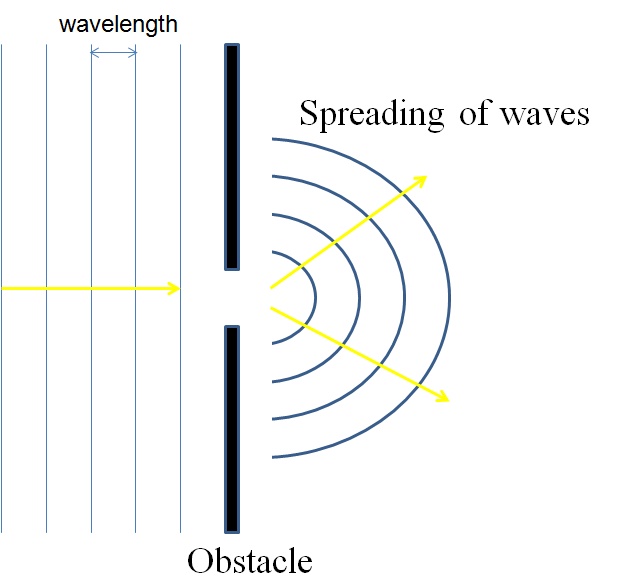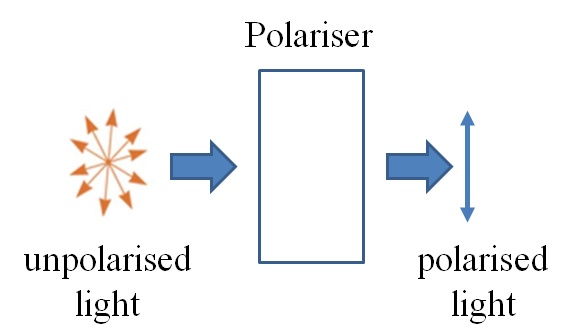Question: Explain, using diagrams, what is meant by the terms diffraction and polarisation of waves.
Diffraction: Diffraction refers to a phenomenon by which there is a spreading of waves through an opening or a bending of waves around an obstacle (see figure 1 below). Diffraction of waves can be observed if the size of the opening or obstacle is comparable to the wavelength of the waves.

Further details on diffraction: According to Einstein and Infeld (1966), “the diffraction of light, the deviation from the rectilinear propagation when small holes or obstacles are placed in the way of the light waves (p. 115).” Historically speaking, Italian philosopher Francesco Grimaldi coined the term diffraction and showed how a single beam of light spreads out through very small slits. However, a mark scheme states that “with the presence of an obstacle, light spreads round it into region that would be in shadow if the light travelled in straight lines. Behind the obstacles or apertures at which diffraction occurs, a diffraction pattern of dark and bright fringes can be observed.” Importantly, diffraction of light is likely observable if the size of an opening or obstacle is comparable to the wavelength of light (from 4 × 10-7 m to 7 × 10-7 m.)
Polarisation: Polarisation refers to a phenomenon by which the oscillation of waves is confined to a single plane after passing through a polariser (see figure 2 below). The waves are transverse in nature such that the plane of oscillations contains the displacement of waves and the direction of energy transfer.

Further details on polarisation: Strictly speaking, there is no unpolarised light. In the words of Feynman, “We have considered linearly, circularly, and elliptically polarized light, which covers everything except for the case of unpolarised light. Now how can the light be unpolarised when we know that it must vibrate in one or another of these ellipses? If the light is not absolutely monochromatic, or if the x– and y-phases are not kept perfectly together, so that the electric vector first vibrates in one direction, then in another, the polarization is constantly changing. Remember that one atom emits during 10−8 sec, and if one atom emits a certain polarization, and then another atom emits light with a different polarization, the polarizations will change every 10−8 sec. If the polarization changes more rapidly than we can detect it, then we call the light, unpolarised, because all the effects of the polarization average out. None of the interference effects of polarization would show up with unpolarised light. But as we see from the definition, light is unpolarised only if we are unable to find out whether the light is polarized or not. Feynman et al., section 33–1 The electric vector of light)”.
A mark scheme on the meaning of polarisation is “the (wave) oscillations occur only in one plane”. In addition, another mark scheme states that “polarised light: (The electric field vector of) the wave oscillates or vibrates in one plane”. However, an important condition for polarisation is that the waves should be transverse in nature such as light waves.
Below is a table comparing the phenomena diffraction and polarisation.
| Diffraction | Polarisation | |
| cause | An opening or obstacle | A polariser |
| characteristic | Spreading or bending of waves | Oscillating or vibrating of waves in one plane |
| condition | The size of opening or obstacle is comparable to the wavelength of waves | The oscillation of waves is perpendicular to its direction of motion or energy transfer |
References:
- Einstein, A., & Infeld, L. (1966/1938). The Evolution of Physics. New York: Simon and Schuster.
- Feynman, R. P., Leighton, R. B., & Sands, M. (1963). The Feynman Lectures on Physics, Vol I: Mainly mechanics, radiation, and heat. Reading, MA: Addison-Wesley.